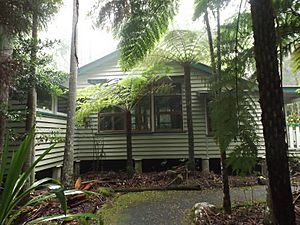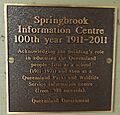Springbrook State School facts for kids
Quick facts for kids Springbrook State School |
|
|---|---|

Building in 2016
|
|
| Location | Springbrook National Park, 2873 Springbrook Road, Springbrook, Gold Coast City, Queensland, Australia |
| Design period | 1900 - 1914 (early 20th century) |
| Built | 1911 - 1953 |
| Architect | Department of Public Works |
| Architectural style(s) | Classicism |
| Official name: Former Springbrook State School (QPWS Information Centre), Queensland Parks and Wildlife Service Information Centre, Springbrook National Park | |
| Type | state heritage (built) |
| Designated | 5 August 2003 |
| Reference no. | 602141 |
| Significant period | 1910s (historical) 1910s-1920s (fabric) 1911-1971 (social) |
| Significant components | school/school room, tree |
| Lua error in Module:Location_map at line 420: attempt to index field 'wikibase' (a nil value). | |
The Springbrook State School is a building with a rich history. It used to be a school but is now an Information Centre for the Queensland Parks and Wildlife Service. You can find it in Springbrook National Park in Queensland, Australia. The school was designed by the Department of Public Works and was built between 1911 and 1953. It is a special place because it is listed on the Queensland Heritage Register.
History of the School
The building that is now the Queensland Parks and Wildlife Service Information Centre was built as Springbrook State School in 1911. A builder named W Norman constructed it. The design was a changed version of a standard school plan from the Queensland Works Department.
Early Settlement in Springbrook
People who were not Indigenous started using the Springbrook area in 1879. At first, it was a Timber Reserve, meaning it was set aside for cutting down trees. But it was hard to get to, so not many trees were cut. In 1905, a Forest Ranger suggested that the area should be opened up for settlers.
In 1906, land became available, and the first settlers arrived in December. Many came from the Bega area in New South Wales. They worked hard to clear the thick bush. They started small farms, mostly for dairy and other produce. Some of their descendants still live in Springbrook today. Within ten years, much of the area was cleared.
Starting the School
The Springbrook State School officially opened in 1911. In 1909, a local resident, James Hardy, asked the Department of Public Instruction about starting a school. At first, there weren't enough children for a full State School. The community also wasn't ready to pay for a provisional school.
The next year, people asked for land to be set aside for a school. In February 1910, a meeting was held to choose a School Building Committee. They sent an application to the Department of Education. An inspector visited and suggested building a school on 15 acres of land. The Department of Public Works was asked to create a plan. They suggested making the building smaller and lower to save money. W Norman won the contract to build it for £209. The building was finished on March 18, 1911. Miss Elisabeth Josephine McMahon was the first teacher. The school opened on April 26, 1911, with fifteen children.
School Life and Changes
In 1912, a very large tree called a New England Mountain Ash was cut down next to the school. Its stump is still there today, and you can see marks from the tools used to cut it. The schoolyard was fenced in 1912. In 1914, a stove was installed in the school, which was helpful in the cold weather.
In 1915, a back verandah was added to the school. Over the years, small repairs and painting were done. In 1932, the school was re-stumped, but the new stumps were too small. This caused the building to sink a bit. In 1953, new windows were put in. A playshed was built in 1954 where an older, rougher shed used to be. In the 1950s, the verandahs were enclosed, and a small room was added to the back verandah.
School Closures and Reopening
The school closed a few times during its history. In 1915, a teacher didn't arrive for several months. In 1929, a new teacher left the day after she arrived, and no one was appointed for a while. By May 1932, only ten students were enrolled. The Director of Education said the school might have to close. Children would have to learn through Correspondence School (learning from home by mail).
After people asked for the school to stay open, the decision was changed. But by January 1933, enrollment dropped to nine students. The school closed in March. There were plans to move the building, but a petition with 29 signatures protested this. In May 1934, an inspector suggested opening the school again for three months to see if more students would attend.
A New Chapter
In 1961, local people celebrated the school's 50th anniversary. They built a memorial cairn (a pile of stones) at Hardy's Lookout. This cairn lists the names of the early settlers of the area.
In 1971, only four children were at Springbrook State School. The school closed in February. The students, furniture, and equipment were moved to Mudgereeba State School. The school land and buildings were then given to the National Parks and Wildlife Service (NPWS). The school building was used for police training and then as offices for the NPWS. Later, it became an Information Centre for Warrie National Park, which is now part of Springbrook National Park.
In 1986, the building was updated. New windows were installed, and a new front verandah and ramp were built. Inside, cork flooring, a pot-belly stove, and information displays were added. The area around the building was also improved with new plants, a boardwalk, and a lookout. When several national parks joined together in 1990, the old school building became the Information Centre for the larger Springbrook National Park. Over the years, the area has been replanted, and the school site is now mostly bushland. In 2003, new water tanks were installed.
As dairy farming became less profitable, farms were divided into smaller pieces of land. The population of Springbrook grew from fifty people in the 1950s to 400 in 1990. A new Springbrook State School opened in 1984 at a different location.
What the Place Looks Like
The former Springbrook State School is now surrounded by many new plants and trees. The site has several parts: the Information Centre building, a playshed, a toilet block, a carpark, a large tree stump, a water trough, and water tanks. There is also a boardwalk and a lookout nearby.
The Information Centre Building
The Information Centre is inside the old school building from 1911. It's a timber building with a gabled roof made of corrugated iron. It has been changed and added to over the years. It has a large main classroom, an enclosed verandah at the back with two rooms, and an extra kitchen. There's also a new front verandah and a ramp for access.
The main classroom is a large room with wooden walls. The ceiling slopes at the ends, which were once open verandahs. The windows on the sides have different types of openings. The window sills are made from special woods like red cedar. The floor is covered in cork tiles. There's a brick area on one wall and the floor to protect from the heat of a pot-belly stove. You can also see a blackboard and display boards.
The three rooms at the back of the building include two rooms that were once part of the verandah, and a newer kitchen. These rooms have similar ceilings and floors to the main classroom. The playshed, built in 1954, is a rectangular wooden building with a concrete floor. It has walls made of alternating wide and narrow wooden boards. Inside the shed, you can see an old Queensland Buckboard, which was a type of cart that belonged to James Hardy, one of Springbrook's early settlers.
Other Features
The toilet block is made of rock and timber with a metal roof. It was built by the National Parks. The carpark is new and was built where the school's tennis court used to be.
The large tree stump is from a New England Mountain Ash tree. It's about 3.5 meters tall and still shows marks from the tools used to cut it down. The water trough was added after 1953 and has three taps. There are also water tanks near the school and playshed. The boardwalk and lookout were built in 1986 from treated pine.
Why It's Special
The former Springbrook State School (now the QPWS Information Centre) was added to the Queensland Heritage Register on August 5, 2003. This means it's considered an important historical site.
A Glimpse into History
This old school building, built in 1911, shows us how the mountain areas of the Gold Coast were settled later than other places. Springbrook was settled quite late, around 1906, and was a small farming community. The former Springbrook State School was the first public building there and is the oldest building still standing on the plateau.
The large tree stump next to the school also tells a story. It shows how people used to clear land, which is very different from how we think about protecting nature today.
A Typical Old School
The building is a good example of a small school from the early 1900s. It was designed by the Queensland Works Department. Even though it has been changed a bit, you can still see its original features. The playshed from 1954 is also a good example of a standard design from the Queensland Works Department.
Important to the Community
The school has a strong connection to the Springbrook community. For sixty years, it was the only place for education and also a social gathering spot for the people living there.
Images for kids
-
New England Mountain Ash stump, 2016




